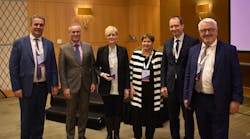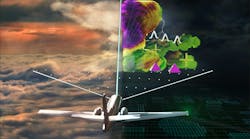Aug. 09--DAYTON -- Employees are moving into the new $51 million GE Aviation electrical power research and design center near the University of Dayton main campus.
The presence of employees in the building at 111 River Park Drive in Dayton is a milestone in this young joint venture between the company and the university. The intent is to use the building to attract more business to GE Aviation and more students to the university.
While only 15 people had relocated to the building as of Thursday, up to 200 researchers could be working there in the next five years, company officials have said.
In the building's 89,000 square feet of labs and 50,000 square feet of offices GE will help its customers design lighter airplanes with greater fuel efficiency to fly people and goods at lower costs, said Vic Bonneau, president of GE Electric Power Integrated Systems.
Owned by the university, the building -- called the Dayton Electric Power Research Lab --
"gives us the ability to compete at a higher level in electric power on aviation platforms," Bonneau said.
GE has a 15-year lease on the building with an option to extend the lease, said Derek Busboom, project manager during construction and today the site's leader.
At the center, GE will take products it designs and develops for airplane customers and assemble them in a way that lets customers see how they work on aircraft.
Before, aircraft customers bought individual components. Now, they want systems already woven together, ready for testing and eventual flight certification, Bonneau said.
That's why the main building is so long, stretching along River Park Drive. Wiring systems and components will be physically laid out in that space. In some sections of the sprawling building, a 787 wing may be mounted on a wall. In another section, a generator may be shaken on a 44,000-pound vibration table, verifying that it can endure the extreme conditions of flight.
"It's built so that it can accept an entire one half of the airplane," said Mickey McCabe, UD vice president of research. Engineers can lay the wiring out and impose crucial tests.
"That is the greatest strength of the lab," Busboom said. "We can configure it for a whole variety of test applications."
Lab space is divided into civilian and military sides, Bonneau said. There's room for two aircraft systems on each side, systems that can stay in place for years, if there's a need for that.
Customer expectations dictated the size and shape of the building, Bonneau said. It's similar to a building GE has in England, but the Dayton structure is four times as large, Busboom noted.
"This building is one of a kind in the world," McCabe said.
Already, the building has strengthened GE's business at other sites, Bonneau said.
The GE Vandalia site has seen sales grow from $70 million a year in 2008 to more than $110 million today, Bonneau said. The Vandalia plant added 30 engineering employees in the past year in preparation for the opening of the new building, he said. The company has run out of space in Vandalia, so some employees are being shifted to Dayton.
"Will GE (Aviation) have more than 1,400 people in this community more than five years from now? I would expect so," Bonneau said. "How many could that be? It probably could be 2,000 people."
Lorraine Bolsinger, former president and chief executive of GE Aviation Systems, has told UD that the building could be home for up to 150 to 200 researchers in the next five years.
But McCabe marvels at the fact that the building appears to have plenty of room for more -- much more.
"When you walk into that building, you realize right away that there could be far beyond 150 to 200 researchers," he said.
By the end of the year, the building will have 60 to 70 people working there. "There's plenty of room," Bonneau said.
Construction employed 17 subcontractors, UD has said. At the height of construction, the daily payroll of $35,000 helped support the families of 120 workers.
One reason university leaders have welcomed the company is that engineering students are expected to be drawn to the site, McCabe said. Students who may have offers from Standford or the University of Michigan may well be tempted to attend UD, where they can work in an actual GE Aviation lab, he said.
UD's Research Institution plans to provide more than $1 million a year in R&D funding to help pay for those students, the university has said.
"I don't see anybody losing," McCabe said. "We're excited about the future. We're doing the job right."
Copyright 2013 - Dayton Daily News, Ohio





